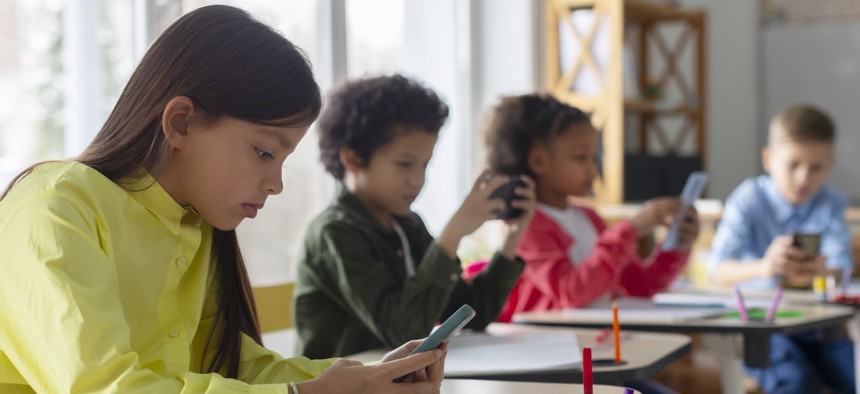Lawmakers highlight success, bipartisan agreement on school cellphone bans

Olena Miroshnichenko via Getty Images
A recent House hearing showcased success at the state and district level as the bans gather steam nationwide. But Democrats warned that reduced federal funding for education will not help improve educational outcomes.
States’ efforts to ban cell phones in schools received bipartisan support in a Congressional hearing this week, although Democrats warned that education and mental health services still need federal support as Republicans float massive cuts.
The hearing before a subcommittee of the House Education and Workforce Committee came as more than two dozen states have either outright banned or restricted minors’ use of cell phones in schools, or encouraged local school districts to pass policies to that end. Seventeen states from across the political spectrum have outright banned devices in classrooms, most recently Nevada and Nebraska, whose governors signed specific legislation last month.
Lawmakers said that states must act, considering the youth mental health crisis, learning loss from the COVID-19 pandemic and the distractions smartphones can cause during the day. But some also noted that classrooms still need to prepare students for a technology-saturated world.
“Now that cellphones, laptops, and tablets have become an integral part of our everyday lives, schools need to be equipped with the latest technology and high-speed internet,” Rep. Suzanne Bonamici, a Democrat from Oregon and the subcommittee’s ranking member, said in her opening statement. “Being fluent in technology is a necessity, not a luxury, especially when students will be entering the workforce in a modern, global economy. But access to and use of technology must come with guardrails.”
The effort has received bipartisan support, as elected officials lamented that students now spend an average of 90 minutes per school day on their own devices during instructional time, in addition to the eight-and-a-half hours the average high school student spends using their cell phone.
“Screens are pervasive, mostly in the form of student cell phones, drawing attention away from interactive discussion and instruction,” Rep. Kevin Kiley, a California Republican and the subcommittee chair, said in his opening statement. “Too often, students spend most of their days with their heads down, thumbs scrolling, and only a fraction interacting with increasingly discouraged teachers. Students spend lunch sitting side-by-side but interacting with their phones rather than their peers.”
Witnesses from states and local school districts highlighted the success of their policies on student cell phone use. Utah Gov. Spencer Cox, a Republican, wrote to every school district in Jan. 2024 urging them to implement a policy that would remove cellphones from classrooms, then the state passed a law banning them and other smart devices during classroom hours.
Rich Nye, the governor’s special advisor for education, told the subcommittee that while school districts are allowed to use their discretion for instances where a phone may be allowed — responding to an imminent threat or an emergency — limiting their use for students helps lower distractions, improve academic results and reduce harms like cyberbullying and isolation.
“This approach aims to re-center student attention on learning, foster healthier interpersonal interactions, and mitigate the documented negative consequences, ultimately creating a more conducive and supportive educational setting for all students,” Nye said.
Local school districts implemented policies several years ago, amid worries about falling student engagement, cyberbullying, fights, academic cheating and the safety concerns associated with social media. Matthew Gibbins, the assistant superintendent in the Richardson, Texas, Independent School District, noted in his testimony that the district first piloted a smartphone-use policy in 2022, then expanded it for the 2023-24 academic year.
Since then, Gibbins said the effects have been dramatic. Some of the district’s 50 campuses just north of Dallas have seen in-school and out-of-school suspensions reduced by as much as 54%, while teacher retention rates have improved, with many saying they have stayed due to the district’s phone-free environment. The district has used Yondr pouches in some schools, where each student receives a sealed personal pouch to store their cellphone during the day, while other campuses require devices to be powered off and out of sight, enforced by staff.
“While we know that student achievement and teacher retention are influenced by many variables, the early results from our phone-free initiative are both meaningful and measurable,” Gibbins said. “When paired with clear policy and strong campus leadership, a phone-free environment can help schools become more focused, less distracted, and more student-centered.”
Texas has since passed a law mandating that school districts adopt a policy prohibiting cellphone use during the school day. That statewide effort joins the likes of bans passed in Oklahoma, Alabama and Iowa, while New York included a similar ban in its most recent state budget.
Despite the positivity radiating from states and local school districts about the impacts of cellphone bans, Democrats on the subcommittee warned of the consequences reduced federal funding will have.
Bonamici said the Trump administration’s decision to cancel more than $1 billion in funding for student mental health services, like mental health specialists, support services and suicide prevention, will have a dramatic effect on schools that “desperately need them.”
She said the administration’s plan to eliminate the Department of Education, as well as its recent decision to fire every employee in the Office of Education Technology that assists districts and states in implementing technology best practices, “will deepen the inequity and instability we’re already seeing across our public education system.”
“I expect that we will all agree that states have control over screen time, and I appreciate again the expertise and time of these witnesses,” Bonamici said. “But I hope we can also work on the urgent challenges that are within our power and jurisdiction, so we get to the point where every student has the opportunity to learn and thrive.”






